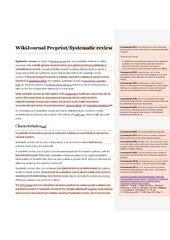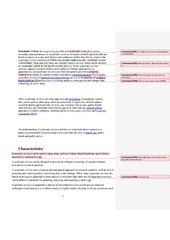Talk:WikiJournal of Medicine/What are Systematic Reviews?
Add topic
WikiJournal of Medicine
Open access • Publication charge free • Public peer review • Wikipedia-integrated
This article has been through public peer review.
It was adapted from the Wikipedia page Systematic_review and contains some or all of that page's content licensed under a CC BY-SA license. Post-publication review comments or direct edits can be left at the version as it appears on Wikipedia.
First submitted:
Accepted:
Article text
PDF: Download
DOI: 10.15347/WJM/2020.005
QID: Q99440266
XML: Download
Share article
![]() Email
|
Email
| ![]() Facebook
|
Facebook
| ![]() Twitter
|
Twitter
| ![]() LinkedIn
|
LinkedIn
| ![]() Mendeley
|
Mendeley
| ![]() ResearchGate
ResearchGate
Suggested citation format:
Jack Nunn; Steven Chang (9 November 2020). "What are Systematic Reviews?". WikiJournal of Medicine 7 (1): 5. doi:10.15347/WJM/2020.005. Wikidata Q99440266. ISSN 2002-4436. https://upload.wikimedia.org/wikiversity/en/7/7a/What_are_Systematic_Reviews.pdf.
Citation metrics
AltMetrics
Page views on Wikipedia
Wikipedia: This work is adapted from the Wikipedia article Systematic review (CC BY-SA). Content has also subsequently been used to update that same Wikipedia article Systematic review.
License: ![]()
![]() This is an open access article distributed under the Creative Commons Attribution License, which permits unrestricted use, distribution, and reproduction, provided the original author and source are credited.
This is an open access article distributed under the Creative Commons Attribution License, which permits unrestricted use, distribution, and reproduction, provided the original author and source are credited.
Roger Watson ![]() (handling editor) contact
(handling editor) contact
Mark Hayter ![]()
Jane Noyes ![]()
Daniel Bressington ![]()
Article information
Plagiarism check
 Pass. Report from WMF copyvios tool: 45.1% Plagiarism; please check the results here - most is associated with direct quotes, which are properly attributed, and with phrases such as 'Cochrane Collaboration', 'Cochrane Library', 'Cochrane Wikipedia Initiative', 'Search strategies' and other stock phrases; I don't think any action is required.Rwatson1955 (discuss • contribs) 15:22, 23 June 2019 (UTC)
Pass. Report from WMF copyvios tool: 45.1% Plagiarism; please check the results here - most is associated with direct quotes, which are properly attributed, and with phrases such as 'Cochrane Collaboration', 'Cochrane Library', 'Cochrane Wikipedia Initiative', 'Search strategies' and other stock phrases; I don't think any action is required.Rwatson1955 (discuss • contribs) 15:22, 23 June 2019 (UTC)
Comment from author on plagiarism check results: I wrote the Cochrane page for how systematic reviews work, then cited this on the wiki page -I then worked (with others) to convert that wiki page to this journal article – adding more content – so the plagiarism check should only be picking up on cited sources that I’ve written myself and are all licensed under creative commons (deliberately so, so I could cite them!). I hope that helps – happy to say more if helpful! Jacknunn (discuss • contribs) 02:18, 2 July 2019 (UTC)
First peer review
Review by Mark Hayter , University of Hull | Editor of Journal of Advanced Nursing
These assessment comments were submitted on , and refer to this previous version of the article
This is an excellent description of the systematic review. I am very glad it highlights that meta-analysis is not always a required component of systematic reviews. I would suggest that where meta-analysis in mentioned the authors also add qualitative meta-synthesis when discussing the potential for analysis of data. I also suggest that CASP is added to the section on quality appraisal.
Thank you for these helpful suggestions. We have added information about qualitative meta-synthesis and also references to relevant CASP resources. Jacknunn (discuss • contribs) 06:40, 21 August 2020 (UTC)
Second peer review
Review by Jane Noyes , Bangor University | Cochrane methodologist and systematic reviewer. Lead convenor of the Cochrane Qualitative and Implementation Methods Group; former co-Chair and now member of the Cochrane methods Executive, Member of the Cochrane Scientific Committee.
These assessment comments were submitted on , and refer to this previous version of the article
It is positive to see an entry on systematic reviews. The entry is however does not reflect contemporary thinking on SR methodology or methods. Overall the article is confused, the section headings do not always match the content and it is not always clear if the content is relevant for this context. The article tries but does not make a convincing attempt to cover all SR types, but the authors appear ill-equipped to do this. Some of the information reported is outdated and incorrect. In some sections information presented is partial and incomplete. The steer is to either refocus the article on the quant review and meta-analysis of intervention effect reviews (for which the authors seem best suited) or to enlist other co-authors who are experienced in other types of SRs to write the additional content and to populate with appropriate and contemporary references. I have attached an annotated version with comments for the authors to consider. .
Thank you for these extensive and extremely helpful comments. We have incorporated all of the feedback contained in the PDF attached by the reviewer. We have also included a table summarising different review types, with references provided to additional sources where there are more detailed information. We feel that these extensive and detailed comments have greatly improved the quality of this article and would like to thank the reviewer for making such a helpful and generous contribution to this article. Jacknunn (discuss • contribs) 06:48, 21 August 2020 (UTC)
Third peer review
Review by Dan Bressington , Hong Kong Polytechnic University | Journal editor with systematic review experience
These assessment comments were submitted on , and refer to this previous version of the article
Review in attached PDF
Thank you to the reviewer for their helpful feedback, we have incorporated all of the suggested changes in the PDF provided by the reviewer. For example, we have included more information about qualitative reviews and extra information about PICOs. Jacknunn (discuss • contribs) 06:48, 21 August 2020 (UTC)
Fourth peer review
Review by anonymous peer reviewer , Co-author of major text on the process of systematic reviewing
These assessment comments were submitted on , and refer to this previous version of the article
Overall this is a good description and explanation of systematic reviewing, which readers at various levels of knowledge and research practice will find useful. I have a few minor criticisms. There is some repetition and potential confusion in the different types of review; the writers should acknowledge a lack of consensus on the boundaries and distinctions between these approaches. The meaning shown for rapid review does not explain how or why it is rapid. The history section lacks substance, omitting Cochrane’s mission of evidence-based medicine, which would be built on systematic reviews. As well as stating how a review should be done, perhaps the authors should draw attention to common flaws; for example, arbitrary exclusion criteria for time period, which undermine rigour and comprehensiveness (McCrae & Purssell, 2016). Some headings could be sharpened; for example ‘present day use’ should be ‘present use’, and the term ‘currency’ may be misleading. With some refinements this will be an excellent Wikipedia entry.
Thank you for this very helpful feedback:
- Added ‘There is not always consensus on the boundaries and distinctions between these approaches’
- Changed ‘systematic’ to ‘repeatable and analytical’
- Added that they are a type of evidence synthesis – as this term is being used more now
- Removed ‘kind of’
- changed currency to 'out-dated'
- edited rapid review definition
- improved history section to include two sentences about Archie and to link to his Wikipedia page
- Changed ‘complete’ to just exhaustive
- Changed sentence to ‘other types of mixed-methods reviews’
- To the point ‘summary scores can be misleading because they weight each item equally; hence they are discouraged’ – we feel the evidence rating point being subjective covered in next sentence – suggest future versions can explore complexities of evidence weighting as this is a sophisticated and complex area for an introduction section?
- Added JBI
- Added sentence ‘A number of reporting guidelines exist to standardise reporting about how systematic reviews are conducted. Such reporting guidelines are not quality assessment or appraisal tools.’
- Did not add umbrella review as many other kinds of review were omitted from the table for brevity and the list is not exhaustive – noting that it is similar to a narrative review and perhaps an exhaustive table can be added in future versions?
- Regarding PEO point I added ‘with other variations existing for other kinds of research’ – as by mentioning one variation, it might mean others have to be included in a table, which is not the focus of this article but might be a good table for a future version?
- Added hand searching but called it ‘manual searching’ (which is just the French etymology meaning the same thing) and added in that it’s known as hand searching – which I did as I feel it is both a jargon term and outdated in an electronic era, while still maintaining a specific meaning, which is why I presented as I have)
- 3: extraction – added ‘for example’ as it’s not possible to describe the method for all review types so I picked the most simple example – perhaps again a table in future versions mighbt better describe this?
- Changed GRADE location and added in more information about assessing eligibility and renamed this section as it’s more about assessing eligibility than quality itself.
- Software can be used to support the selection process including text mining tools and machine learning, which can automate aspects of the process. The ‘Systematic Review Toolbox’ is a web-based catalogue of tools, to help reviewers chose appropriate tools for reviews.
- Added reference for Lau
- added about arbitrary time limits
- Changed sentence to read ‘Many organisations around the world use systematic reviews, with the methodology depending on the guidelines being followed.’
- We did not list all tools for conducting reviews and only listed some from the systematic review – some of the examples given were not in this review. However future versions of this paper might include a more exhaustive table?
Jacknunn (discuss * contribs) 05:10, 16 September 2020 (UTC)




